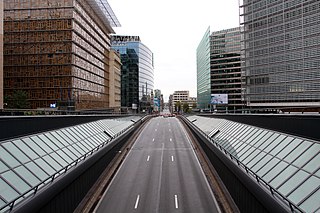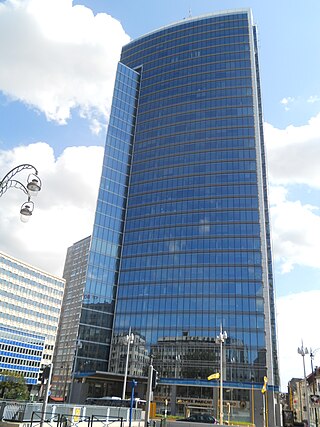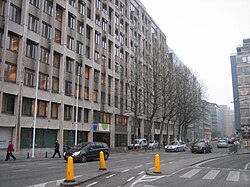
The European Council is where EU leaders meet to set EU's political agenda, but they do not pass laws.

The European Commission (EC) is part of the executive of the European Union (EU). It operates as a cabinet government, with 27 members of the Commission headed by a President. It includes an administrative body of about 32,000 European civil servants. The commission is divided into departments known as Directorates-General (DGs) that can be likened to departments or ministries each headed by a Director-General who is responsible to a Commissioner.

The Berlaymont is an office building in Brussels, Belgium, which houses the headquarters of the European Commission, the executive branch of the European Union (EU). The structure is located on the Robert Schuman Roundabout at 200, rue de la Loi/Wetstraat, in what is known as the "European Quarter". The unique form of the Berlaymont's architecture is used in the European Commission's official emblem. The building is named after the Convent of the Ladies of Berlaymont.

Brussels-Schuman railway station is a railway station in the City of Brussels, Belgium, serving the European Quarter. It received its name from the area around the Robert Schuman Roundabout, itself named after Robert Schuman, one of the founding fathers of the European Union.

The Rue de la Loi or Wetstraat (Dutch), meaning "Law Street", is a major street running through central and eastern Brussels, Belgium, which is famous due to the presence of several notable Belgian and European Union (EU) governmental buildings. The road runs from the Rue Royale/Koningsstraat, in central Brussels, to the Robert Schuman Roundabout in its European Quarter. It forms the first (westerly) part of the N3 road that runs to Aachen, Germany.

The Justus Lipsius building, located in the European Quarter of Brussels, Belgium, was the headquarters of the Council of the European Union from 1995, and the de facto home of the European Council from 2002, until their relocation to the adjacent newly constructed Europa building at the beginning of 2017.
The seven institutions of the European Union (EU) are seated in four different cities, which are Brussels (Belgium), Frankfurt am Main (Germany), Luxembourg (Luxembourg) and Strasbourg (France), rather than being concentrated in a single capital city. All four were chosen, among various reasons, for their location halfway between France and Germany, the countries whose rivalry led to two World Wars and whose reconciliation paved the way for European integration. The EU agencies and other bodies are located all across the union, but usually not fixed in the treaties. The Hague is the only exception, as the fixed seat of the Agency for Law Enforcement Cooperation (Europol). Luxembourg City is the EU capital that can lay claim to having the most of the seven EU institutions based wholly or partly upon its territory, with only the European Council and European Central Bank not having a presence in the city. Over the years, Brussels has become the EU's political hub, with the College of the Commissioners – the European Commission's politically accountable executive – and the European Council both meeting at their Brussels-based headquarters, and the European Parliament and Council of the EU holding the majority of their meetings annually within the city. This has led media to describe it as the de facto "capital of the EU".

The city of Strasbourg in France is the official seat of the European Parliament. The institution is legally bound by the decision of Edinburgh European Council of 11 and 12 December 1992 and Article 341 of the TFEU to meet there twelve times a year for a session, each of which usually takes about four days. The majority of work, however, takes place in Brussels, and some other work is undertaken in Luxembourg City. Also all votes of the European Parliament must take place in Strasbourg. "Additional" sessions and committees take place in Brussels. Although de facto a majority of the Parliament's work is now geared to its Brussels site, it is legally bound to keep Strasbourg as its official home; a situation which garners much criticism from the European Parliament itself, as well as many interest groups, administrative staff, and environmentalist groups amongst others.

Brussels (Belgium) is considered the de facto capital of the European Union, having a long history of hosting a number of principal EU institutions within its European Quarter. The EU has no official capital but Brussels hosts the official seats of the European Commission, Council of the European Union, and European Council, as well as a seat of the European Parliament. In 2013, this presence generated about €250 million and 121,000 jobs. The main rationale for Brussels being chosen as "capital the European Union" was its halfway location between France and Germany, the two countries whose rivalry played a role in starting the two World Wars and whose reconciliation paved the way for European integration.

The Charlemagne building is a high-rise in the European Quarter of Brussels, Belgium, which houses the Directorate-General for Economic and Financial Affairs, the Directorate-General for Trade, and since 2015, the Internal Audit Service of the Commission. It is named after Holy Roman Emperor Charlemagne.

The Europa building is the seat of the European Council and Council of the European Union, located on the Rue de la Loi/Wetstraat in the European Quarter of Brussels, Belgium. Its defining feature is the multi-storey "lantern-shaped" construct holding the main meeting rooms; a representation of which has been adopted by both the European Council and Council of the EU as their official emblems.

The Espace Léopold or Leopoldruimte is the complex of parliament buildings in Brussels, Belgium, housing the European Parliament, a legislative chamber of the European Union (EU). It consists of a number of buildings, primarily the oldest, the Paul-Henri Spaak building, which houses the debating chamber and the President's offices, and the Altiero Spinelli building, which is the largest. The buildings are located in the European Quarter of Brussels, with construction starting in 1989.

The Madou Plaza Tower is a skyscraper in Brussels, Belgium. It was built in 1965, renovated between 2002 and 2006, and taken over by the European Commission. It is located on the Small Ring, in the municipality of Saint-Josse-ten-Noode, at 1 place Madou/Madouplein. It hosts the Commission's Directorate-General for Competition.

The Brussels Parliament building is a neoclassical building located on the Rue du Lombard/Lombardstraat in Brussels, Belgium, housing the Parliament of the Brussels-Capital Region. It largely dates from the early 20th century, although some wings date back to the 17th century and certain later renovations.

There are a range of European institutions in Strasbourg (France), the oldest of which dates back to 1815. In all, there are more than twenty different institutions based in the Alsatian city.

The Robert Schuman Roundabout, sometimes called Robert Schuman Square, is a roundabout at the end of the Rue de la Loi/Wetstraat in Brussels, Belgium, that serves as a focus for major institutions of the European Union (EU). It is named after Robert Schuman, one of the founding fathers of the European Union, and gives its name to the surrounding district and Brussels-Schuman railway station.

The Place Jean Rey is a square in the European Quarter of Brussels, Belgium. It was inaugurated in 2001 and is named after Jean Rey, the second President of the European Commission.

The Lex building is a high-rise of government offices in the European Quarter of Brussels, Belgium. It is an annex building of the Council of the European Union and is located at 145, rue de la Loi/Wetstraat.

The Convent Van Maerlant is a former convent which consists of a church and the Chapel of the Resurrection on the Rue Van Maerlant/Van Maerlantstraat in Brussels, Belgium. It is named after Jacob van Maerlant, a famous medieval Flemish poet.

The Jacques Delors building is an office building in the European Quarter of Brussels, Belgium, which houses the European Economic and Social Committee and the Committee of the Regions. It is located at 99–101, rue Belliard/Belliardstraat, next to Leopold Park, and was formerly called the Belliard building.





















